Arrive Delhi
On arrival, after clearing Immigration, you will be escorted to your hotel.
Delhi, the capital and the third largest city of India, is a fusion of ancient and modern. Standing at the western end of the Gangetic Plain, it is a vibrant city rich in culture, architecture, beautiful gardens and human diversity. Its rich history is reflected in magnificent monuments, in museums and in galleries. It comprises two contrasting yet harmonious parts, Old Delhi and New Delhi. Old Delhi was the capital of Muslim India from the 12th to the 19th centuries, while New Delhi was created by the British Raj and replaced Calcutta (now Kolkata) as the capital in 1931. It is India’s main international gateway, and the travel hub of Northern India.
Check into the hotel and spend the rest of the day at leisure.
Overnight in Delhi



Breakfast at the hotel.
Later proceed for a combined sightseeing of Old and New Delhi.
Morning sightseeing of Old Delhi includes the Jama Masjid, Chandni Chowk, Red Fort and Raj Ghat.
Drive Past Red Fort: The red sandstone walls of the massive Red Fort (Lal Qila) stretch some two kilometres and rise to 33 metres above the clamour of Old Delhi. It was a fort and royal residence, and a striking reminder of the magnificent power of the Mughal emperors. (Closed on Mondays).
Jama Masjid: This great mosque is the largest in India, built by Shah Jahan between 1644 and 1658. With a courtyard capable of holding 25,000 devotees, the highly decorative mosque has three great gates, four towers and two 40 metre high minarets constructed of alternating strips of red sandstone and white marble.
Chandni Chowk: Chandni Chowk, the bustling oriental bazaar, is next to the Red Fort and Jama Masjid. It was built in 1650 by Shah Jahan's favourite daughter, Jahanara Begum, as a compliment to the imperial habitat, the Red Fort.
Raj Ghat: Set in a lovely garden a black marble platform on the banks of the Yamuna River marks the place where “the father” of the Nation, Mohandas Karamchand Gandhi (popularly known as Mahatma Gandhi) was cremated after being assassinated in 1948.
Afternoon sightseeing of New Delhi includes the Qutab Minar, Humayun’s Tomb, India Gate, Lakshmi Narayan Temple, and a drive past various Government buildings including Parliament House and Rashtrapati Bhawan.
Qutab Minar: An excellent example of Afghan architecture, the Qutab Minar is a soaring, 73 metre high tower of victory. Started in 1193 by Qutab-ud-din Aibak, immediately after the defeat of Delhi's last Hindu kingdom, it was completed by his successors. Gracefully hand-carved for its entire height, it has five distinct storeys, each marked by a projecting balcony and tapers from a 15-metre diameter at the base to just 2.5 metres at the top. The lower three storeys are red sandstone, while the upper two are of marble and sandstone.
Humayun’s Tomb: Built in 1565 A.D. nine years after the death of Humayun, by his senior widow Bega Begam. Refined over the years, this striking and beautiful tomb’s design evolved into the Taj Mahal. Notable feature are the centrally located well proportional mausoleum topped by double dome and the garden squares (chaharbagh) with their pathways water channels.
India Gate: At the eastern end of the Raj Path in New Delhi stands the 42 metre high India Gate. An arch of triumph, it commemorates and bears the names of the 90,000 Indian soldiers who lost their lives during the World War I and North West Frontier (Afghan) campaigns.
Overnight in Delhi

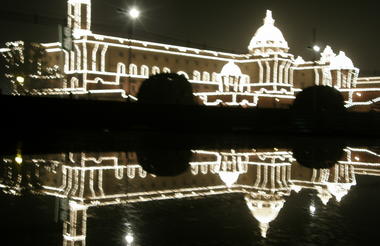
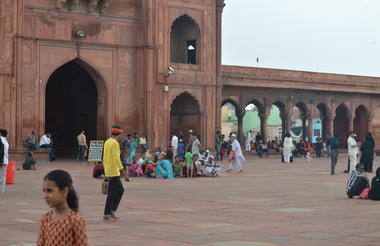
After an early breakfast, check out and drive to Jaipur.
Jaipur is the state capital of Rajasthan and owes its name, planning and foundation to the Maharaja Jai Singh II. In 1727 he decided to move from his hillside fortress at Amber to the plains, and thus Jaipur was conceived.
It is also known as the "Pink City", derived from the pink painted sandstone from which the buildings in the old walled city are constructed. The city is endowed with great architectural elegance and beauty, with magnificent historic palaces, temples, gardens, museums and an amazing observatory built by Jai Singh.
Afternoon, sightseeing of Jaipur City: A city tour takes you through the bazaars to the Maharaja's City Palace. Part of it is now a fine museum with a comprehensive display of historic artefacts. A relatively small portion of the palace is still used by the Royal family of Jaipur.
Built in the style of a fortified campus, one of the palaces is the Hawa Mahal, known as the Palace of the Winds. Built in 1799 this five-story building looks out over the main street, and was originally for the ladies of the royal household to be able to watch life outside the cloistered Royal Residence.
Nearby is the Jantar Mantar, which has the largest stone and marble crafted observatory in the world. Built by Jai Singh in 1728, it is still equipped with the its original ancient instruments including a very accurate 90-foot sundial. Many of them are still in working condition.
Overnight in Jaipur
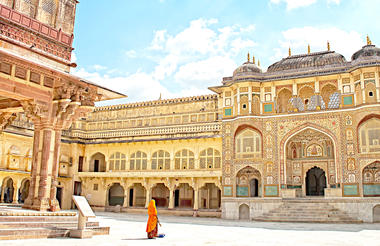


Breakfast at the hotel.
Morning, sightseeing of Amber Fort with elephant ride: Seven miles outside the city, in the rugged hills that surround Jaipur, is the magnificent Amber Fort. An elephant will take you up the steep road to the fort, passing through huge gateways and pillared pavilions. This Rajput Fortress/Palace was constructed from 1592 by Raja Man Singh II, and is a superb example of Rajput architecture. Within the Fort is Jai Mandir (Sheesh Mahal - Palace of Mirrors), renowned for its architectural designs using mirrors of varied shapes and sizes in the intricate design of its wall decoration.
Later check out from your hotel and drive to Agra.
Enroute visit Fatehpur Sikri.
Fatehpur Sikri: (World Heritage Site) Located 40 km from Agra, it was built by Emperor Akbar in 1569, in honour of the great Saint Sheikh Salim Chisti, who blessed Akbar and prophesised the birth of a son, who later became Emperor Jehangir. It is in a superb and complete state of preservation, and within the walls are palaces and the Jama Masjid. The main entrance is the 54 metre high Buland Darwaza, the Gate of Victory
Later continue to Agra.
Agra was the capital of the Afghan King Sikandar Lodhi’s empire from 1501. It passed to the Mughal’s soon after and in 1526 Emperor Babar transformed Agra, giving it a unique character and beauty. A great patron of the arts, he made changes to the culture and life-style of his people, which in turn brought forth some of the finest craftsmen, artists, statesmen ,warriors and nobility ever seen in this part of India.
Over the next few centuries Agra witnessed a rise in pomp and pageantry under the rule of three great Mughal monarchs - Emperors Akbar, Jehangir and Shah Jahan. All lavished their love and riches on this fabled city, making it one of the great centres of art, culture, learning and commerce.
Overnight in Agra
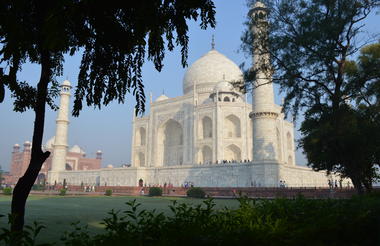
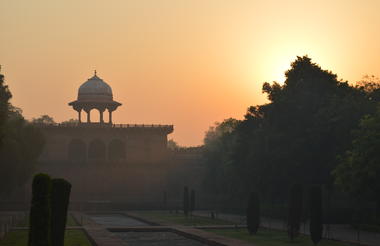
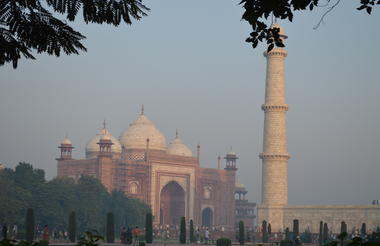
Sunrise visit to Taj Mahal.
Sunrise visit to the Taj Mahal, which was built by Shah Jahan between 1631 to 1653 in memory of his queen Mumtaz Mahal to enshrine her mortal remains. This architectural marvel is a perfectly proportioned masterpiece fashioned from white marble and in-laid with precious and semi precious stones. It stands testimony to the skill of some 20,000 craftsmen brought together from Persia, Turkey, France and Italy, and who laboured for 22 years to complete this ‘Love Poem in Marble'. (closed on Fridays)
Breakfast at hotel.
Later proceed for Agra City tour includes visit to Agra Fort and Itimad-Ud-Daulah Tomb.
Agra Fort was built principally as military establishments by Akbar in 1565. However it was partially converted into a palace during Shah Jahan’s reign. Though Akbar built the original structure, his grandsons made many additions. This powerful fortress encompasses the imperial city of the Mughal rulers within its 2.5 kilometre enclosure walls.
Itimad-Ud-Daulah Tomb: This is the first example of Mughal architecture using marble. It was built by Empress Nur Jahan, in memory of her father Ghias-Ud-Din Beg, between 1622 and 28. She was daughter-in-law of Emperor Akbar, and he the grandfather of Mumtaz Mahal. A graceful building much smaller than the Taj Mahal is also the first example in Mughal architecture of a building faced entirely in marble. The in-lay work is exquisite.
After your sightseeing, you will be transferred to railway station for your overnight train to Katni (Bandhavgarh).
Packed Dinner or Dinner at Local restaurant (as time permits).
SECTOR TRAIN NO. TRAIN NAME DEPARTURE ARRIVAL CLASS
Agra – Katni NZM JBP SF EXP 22182 2030 hrs 0635 hrs + 1 2nd Ac Class
Overnight Onboard Train
Arrive Katni at 0635 hrs by Nzm Jbp Express.
Upon arrival in Katni, you will be met and driven to Bandhavgarh.
Bandhavgarh National Park is located in the Vindhya Hills in the state of Madhya Pradesh. With a diverse variety of habitats it is home to a large cross section of game, including Royal Bengal tigers. Indeed the tiger population at Bandhavgarh is one of the highest in India. The park comprises a core area of 105 sq km and a buffer area of around 400 sq km. Its topography includes steep ridges, undulating forest and open meadows making it one of India's most scenic national parks.
Breakfast, lunch and dinner at Lodge.
Afternoon Game Drive by Exclusive Gypsy.
Evening visits to the National Park. Its steep cliffs, rocky hills covered with 44,884 hectare of dense Sal and bamboo forests make it ideal terrain for tigers. Other inhabitants include leopard, jackal, jungle cat, wild boar, sloth bear, nilgai and sambar. Bandhavgarh attracts many migratory birds in the winter months, including birds of prey - steppe eagle - and a variety of wildfowl.
Overnight in Bandhavgar
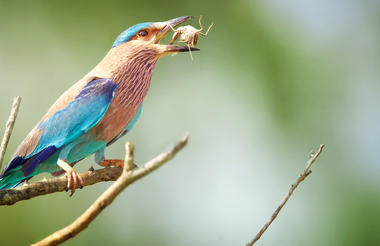
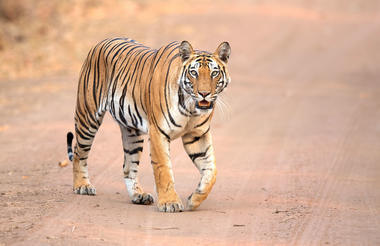
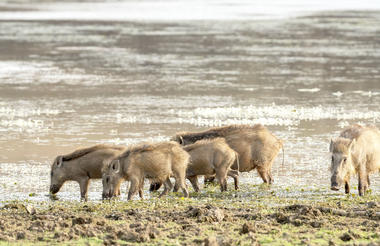
Morning and afternoon Game Drives by exclusive Gypsy (4WD vehicle)
Daily breakfast, lunch and dinner at the lodge.
Overnight in Bandhavgarh



After breakfast, check out and drive to Khajuraho.
The temples at Khajuraho are fine examples of Indo-Aryan architecture. Often called the Temples of the Karma Sutra, they are one of India’s major attractions. Built by the rich and powerful Chandela Emperors, whose dynasty survived for five generations before falling to the onslaught of Islam, the temples are magnificent, and richly carved with erotic images, the recurrent theme being woman in all her glory. There are some 85 temples, most dating from a one century-long burst of creative genius between 950 and 1050 AD. Each temple has a number of spires in ascending order representing man's aspirations.
Arrive Khajuraho, check in at hotel and spend rest of the day at leisure.
Overnight in Khajuraho
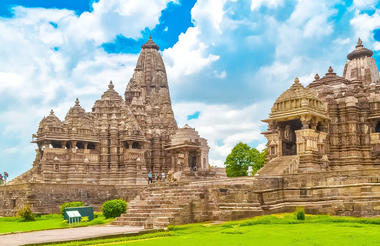
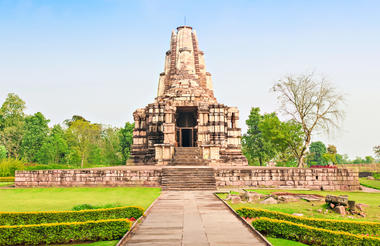
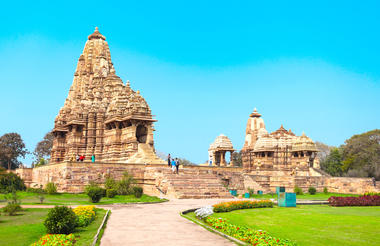
After an early breakfast, proceed to visit world famous Khajuraho Temples.
The Western Group: Comprising 10 temples, these are the best known, and most interesting. The two largest, the Kandariya Mahadev, and Lakshmana belong to this group. Kandariya Mahariya is artistically and architecturally the most perfect. Built around 1030 AD it presents Chandella art at its most refined. The main spire is 31 metres high with prolific carving. In total there are some 872 statues and carvings both on the inside and outside. Though similar in design the Lakshmana temple is dedicated to Vishnu, and is one of the oldest temples, dating from around 930 AD. It is also the best preserved.
The Eastern Group: Comprising seven temples, the main being the Parsvanath, Adinatha and Santinatha Jain temples in a walled enclosure, and four others, the Ghantai, Brahma, Vamana and Javari, which are scattered through the village. All covered with carved images in a variety of sensuous attitudes: languid, provocative, mischievously inviting, give credibility to the theory that Khajuraho's erotica were meant to test the devotees who came to worship their gods at the temples.
Later check out and you will be transferred to the airport for your flight to Varanasi.
SECTOR AIRLINE FLIGHT DEPARTURE ARRIVAL CLASS
Khajuraho – Varanasi Air India AI 405 1600 hrs 1700 hrs Economy
Upon arrival in Varanasi, you will be met and driven to the Ghats for evening arti at the Ganges.
Evening tour of the downtown area by rickshaw: An intimate experience of Varanasi on a leisurely cycle rickshaw ride through the narrow streets and alleys of the city. In the evening the Ghats and temples are atmospheric, lit with candles and oil-lamps. There will be the opportunity to participate in an Arti Ceremony (collective prayer) and watch the floating Diyas (lamps) on the River Ganges.
Varanasi (also known as Benares and Kashi), standing on the western bank of the sacred River Ganges, is the most important Hindu pilgrimage site. One of the world’s oldest living cities, its history stretches back into the mists of time. It has been a centre of learning for over 2,000 years. At Sarnath, just 10 Km away, Lord Buddha preached his first message of enlightenment 2,500 years ago.
The relationship between the river and the city is the essence of Varanasi. Along the water's edge are bathing and burning Ghats, where devout Hindus come to bath in the sacred waters and the departed are cremated on pyres of sandalwood. The most sacred Ghat is Manikarnika, associated with the Goddess Parvati. In the heart of the city is the majestic Vishveswara Temple, dedicated to Shiva, the Lord of the Universe, who according to legend, after his marriage to Devi Parvati, left his Himalayan abode and came to reside in Kashi with all the gods in attendance.
Overnight in Varanasi
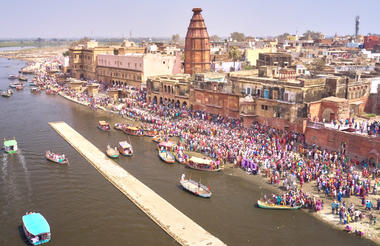
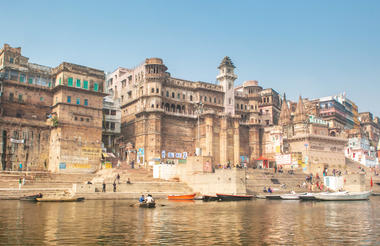
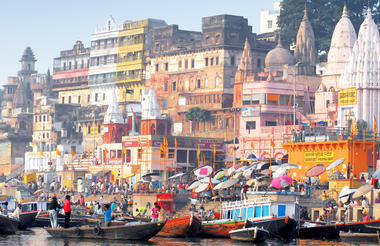
Breakfast at your hotel.
In the early morning enjoy a boat ride.
The best time to visit the Ghats is at dawn, so an early start today. At this time the city is just waking-up and the light is magical, playing on the water and the buildings. The boat will cruise along the waterfront and the spiritually uplifting activity along the Ghats is viewed. From dawn to dusk the Ghats are thronged by thousands of devotees, who perform their holy rituals in the hope of attaining eternal salvation or Nirvana.
Following boat ride, proceed for a walking tour of Old Varanasi visiting the Kashi Vishwanath Temple, Bharat Mata Temple, etc.
Kashi Vishwanath Temple (Golden Temple); In the heart of the city is the majestic Vishveswara Temple, dedicated to Shiva, the Lord of the Universe, who, according to legend, after his marriage to Devi Parvati left his Himalayan abode and came to reside in Kashi with all the gods in attendance. Maharani Ahilya Bai Holkar of Indore built the Temple in its present form in 1776, and it has been a living embodiment of India’s timeless cultural traditions and high spiritual values.
Bharat Mata Temple: Dedicated to “Mother India” it was opened by Mahatma Gandhi in 1936. Instead of customary gods and goddesses, the unique aspect of this temple is a perfect relief map of India. It can be viewed from above and from a sunken “room” looking across India from the far south to the Himalayas in the north.
In the afternoon there is the Sarnath Excursion.
Situated 10 km from Varanasi, Sarnath is one of the four most important Buddhist pilgrimage centres in India. Having found enlightenment at Bodhgaya, it is where Lord Buddha delivered his first sermon to his disciples, preaching the middle path for attaining 'Nirvana'. Realising the sanctity of the site, emperor Ashoka built fine Stupas and other monuments. The 'Dhamekh' Stupa is perhaps the most remarkable structure. It was at its height in 640 AD when some 1,500 priests were in residence.
Overnight in Varanasi



Leisurely morning with breakfast at your hotel.
Later check out and you will be transferred to railway station for your overnight train to Farakka.
SECTOR TRAIN NO. TRAIN NAME DEPARTURE ARRIVAL CLASS
Varanasi – Farakka 13484 FARAKKA EXPRESS 1515 hrs 0556 hrs + 1 2nd Ac Class
Packed Dinner on board
Overnight onboard train






Sailing on downstream past fine waterfront buildings and the Old Dutch settlement at Chinsura you land at Chandernagore, a French possession until 1950, and visit the 18th century church and Dupleix’s House containing a small museum. Continue down to Barrackpore, land and take a walk through the cantonment past the Semaphore Tower, Government House, the Temple of Fame, and Flagstaff House, its garden housing many of the British statues removed from central Calcutta. Sail on up to Bali Bridge.
Overnight onboard cruise

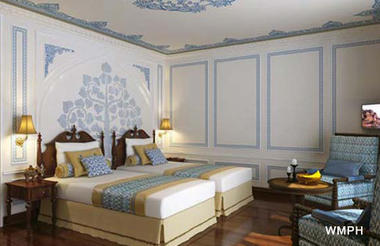
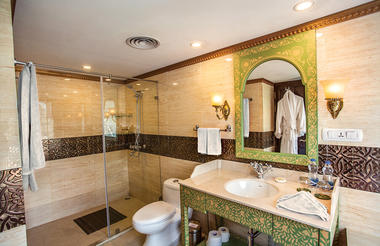
Breakfast at your hotel (Standard checkout time 12.00 noon).
Later check out and you will be transferred to the airport for your flight back home.
“END OF OUR SERVICES”






